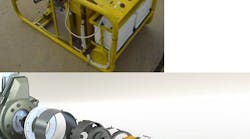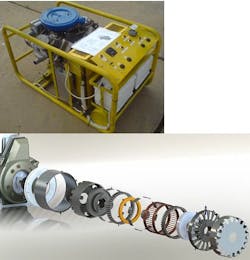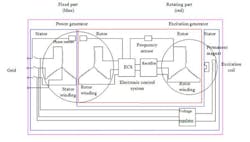Generator works without high-power electronics
A researcher in Russia thinks he has a way of generating power from wind turbines and other rotating devices that is super-efficient thanks to the elimination of any intervening power conversion electronics.
The basic idea, as described by Sergey Gandzha of South Urals State University, is to adjust the output of a generator by adding to or subtracting magnetic flux. In his scheme, permanent magnets generate most of the flux. Smaller electromagnets are then controlled in such a way as to add or subtract from the PM flux to get the kind of output desired.
Gandzha has devised a dc alternator that uses this method. He says the same concept could be used to create generators that connect directly to the power grid without the need for intervening conversion electronics. The resulting boost in efficiency could be significant, he claims.
In conventional rotating generators or alternators, the output voltage rises with the rotational speed of the rotor, simply because output voltage is proportional to the change in magnetic flux per Maxwell’s equations. For dc generators, the resulting ac output is usually rectified to dc using power semiconductors. For ac generators, the varying ac voltage is usually rectified to dc and then converted back to grid-synchronized ac with an inverter. But there is a significant equipment and energy cost to these conversions when working with power levels that characterize utility scale wind turbines.
Gandzha thinks his method will eliminate the need for intervening ac/dc conversion and inverter electronics. He says an 8-kW battery charger built at SUSU using his ideas generated a constant 28 Vdc over a broad range of rotational speeds. Researchers controlled the electromagnets using just a low-power excitation circuit.
Gandzha’s success with the dc generator makes him think an ac generator using the same principles would work well. But he has yet to assemble a complete ac device. His research team has put together portions of an ac generator for testing which use slip rings and external signal generators to produce excitation signals for the electromagnets. When it is complete, the ac generator will host the low-power excitation electronics on the rotor itself. This approach eliminates the brushes and slip rings.
Gandzha is working with Empire Magnetics Inc. in California on future developments. The group is trying to get additional funding to complete the development and produce more prototypes.



